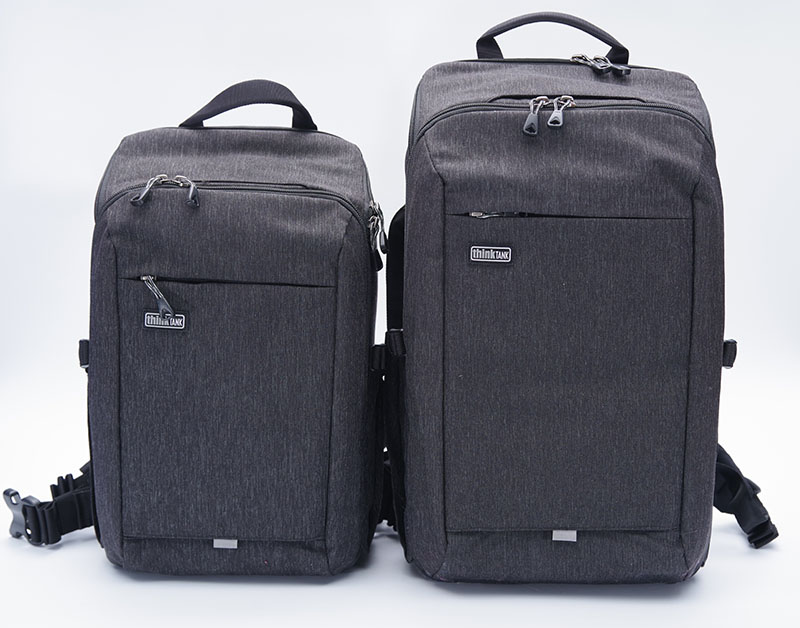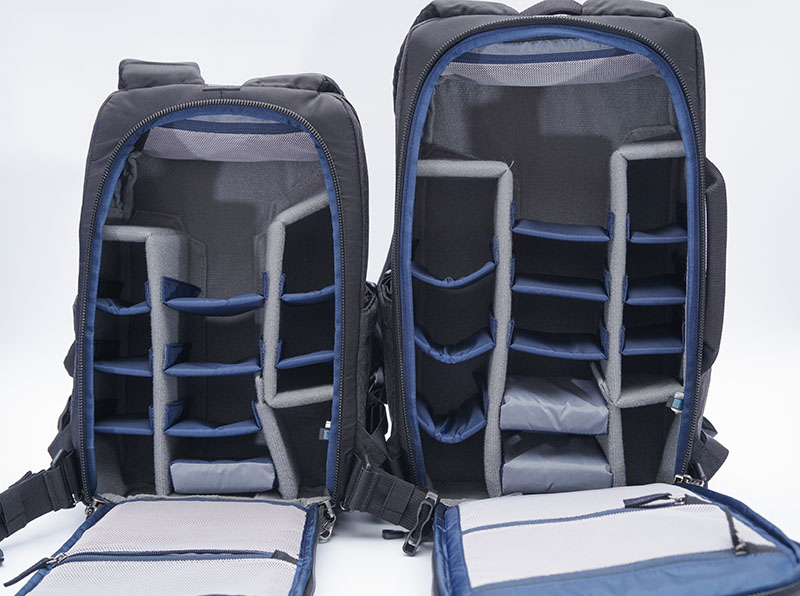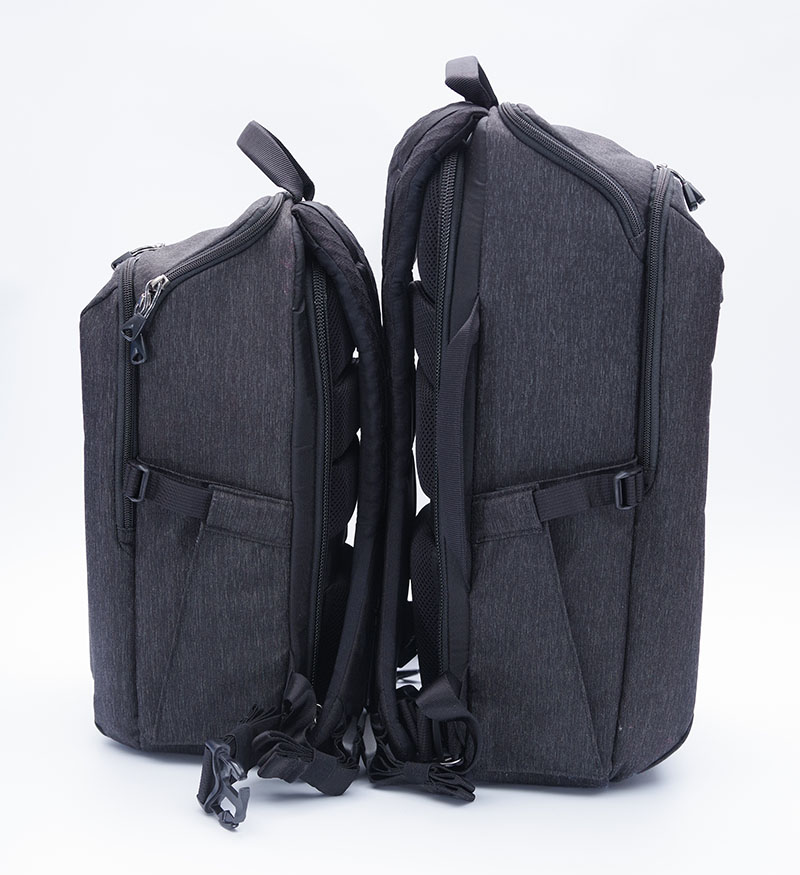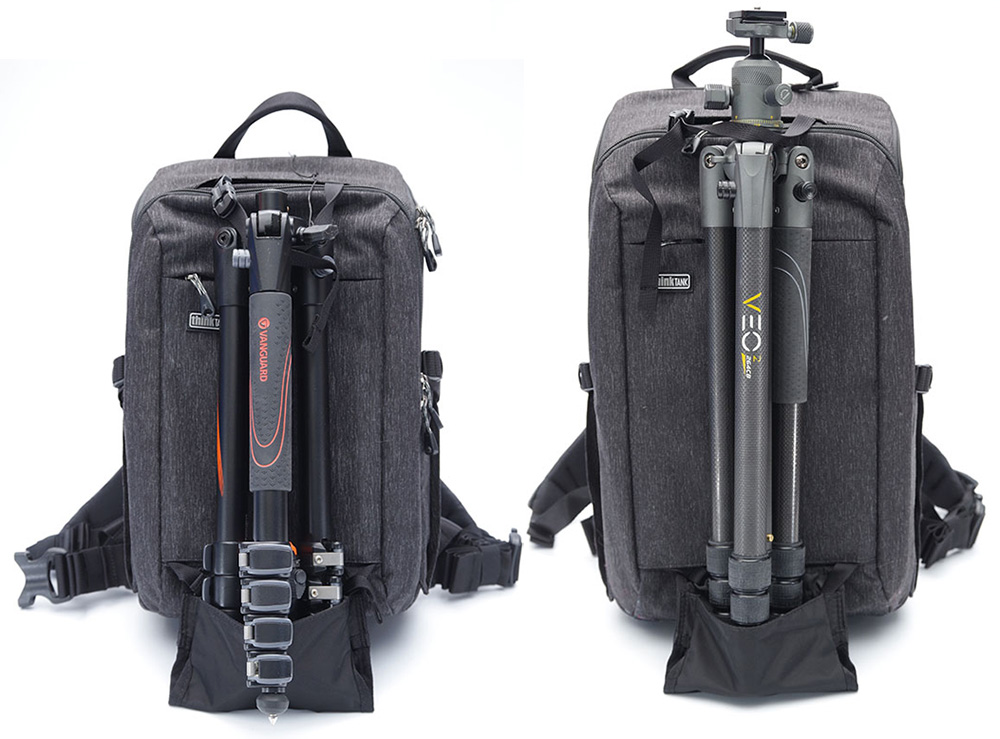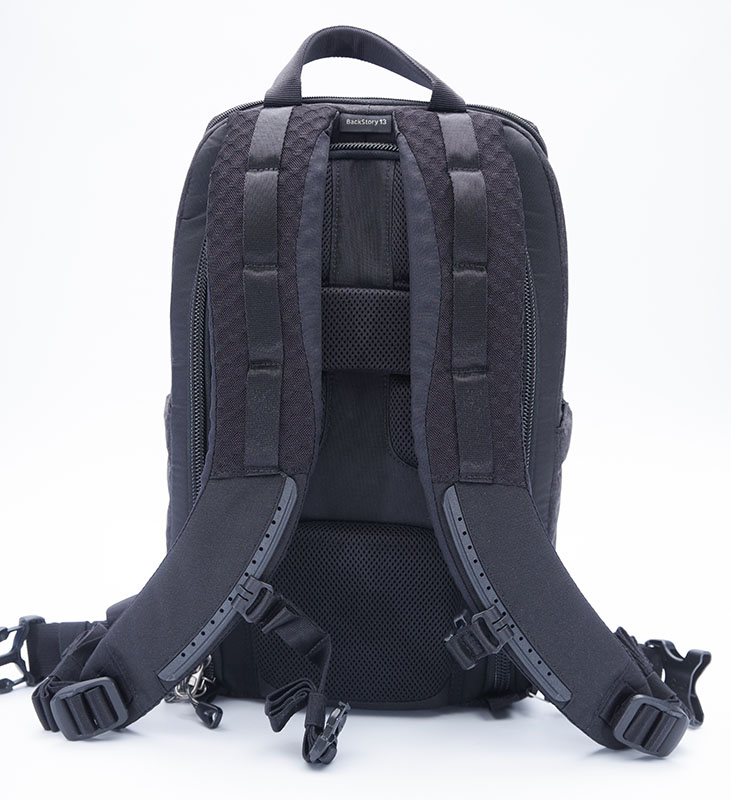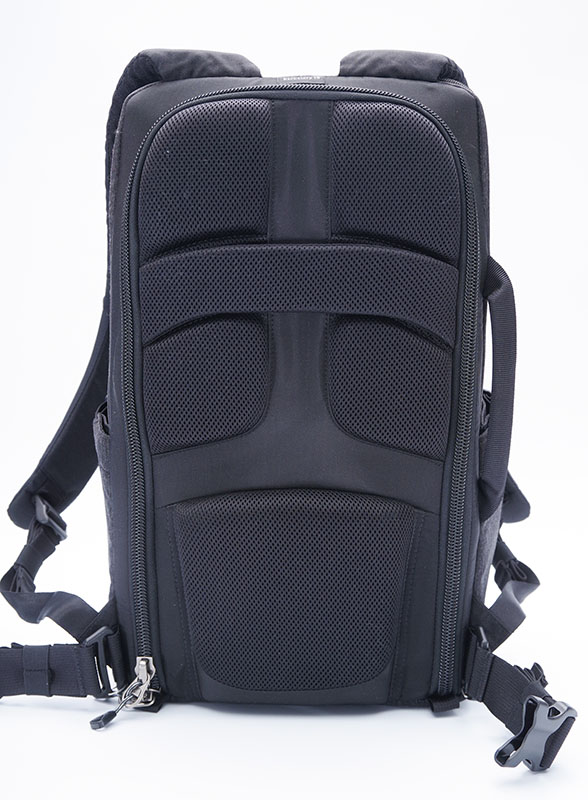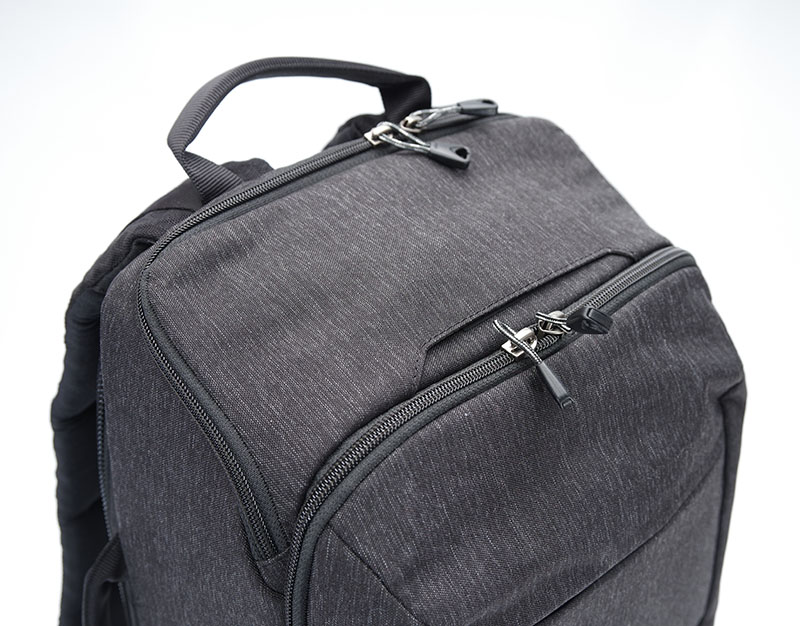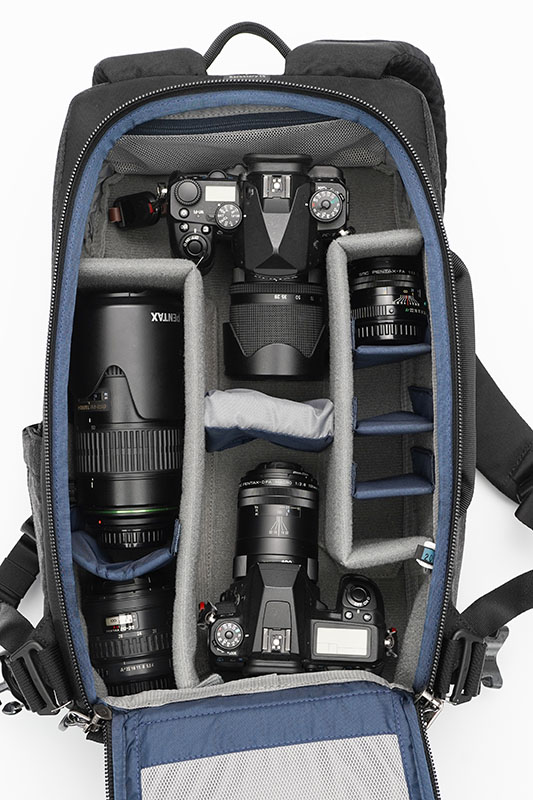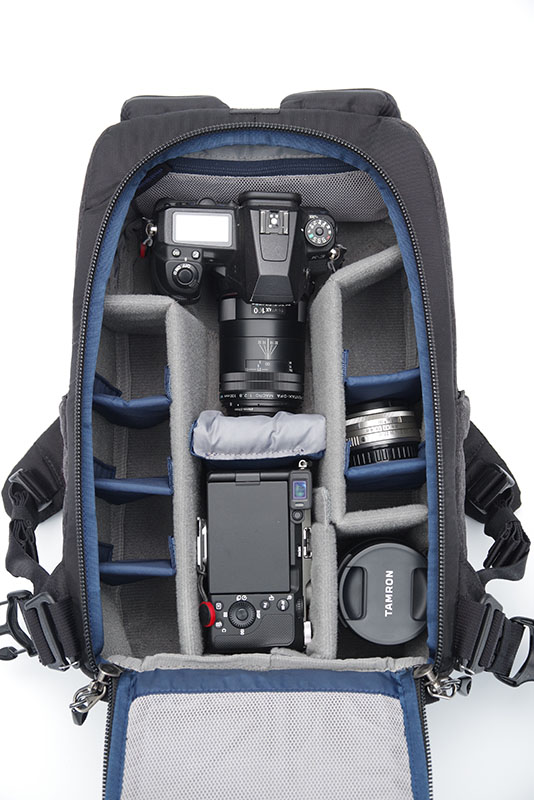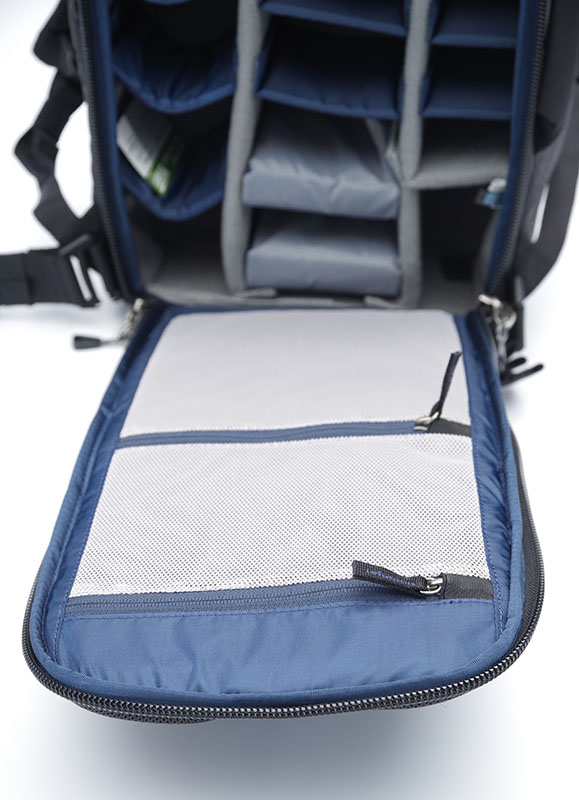Following in the tracks of their successful Urban Access series, Think Tank Photo recently released two new backpacks, the Backstory 13 and 15. Using the same dark gray colouring and general styling of the Urban Access, the Backstory backpacks offer a different approach to storage and access.
Photographers on the move often wish for quick access, while photographers who go on location with a lot of equipment generally prefer a large opening to reach all their gear at once. The Backstory design provides a little of both approaches, with emphasis on a wide back panel to reach the whole interior. Top access lets the user grab the camera quickly, and the inside dividers can be organized to separate the top section from the rest of the bag in order to carry extra accessories. In the default configuration, the Backstory utilizes the whole volume of the bag for camera equipment.
On each side is a deep pocket, perfect for a water bottle or small tripod. These pockets can be tightened or closed flat by a nylon band. The nylon band tucks away neatly when not in use. At the front is a wide, narrow compartment which holds the laptop and tablet sleeves, as well as a deep front portion for documents or perhaps a light jacket. There is a large mesh pocket and several sleeves for pens, business cards and the like. The front compartment is too slim for thicker items, such as headphones, but is ideal for a power bank, chargers, or spare batteries.
The front also features Think Tank’s unique and effective tripod carry system. A strap tucks away at the top and a pocket is hidden at the bottom. This arrangement can hold a tripod in place, centering it on the backpack for comfort and stability. The Backstory 13 is well matched to smaller travel tripods, while the Backstory 15 can accommodate larger, full-size tripods. On the 15, a travel tripod will require that the center column be extended, otherwise the top of the tripod will end up lower than the top strap. The side pockets can also carry smaller tripods with ease.
On the front panel, there is a small pocket that is ideally sized to carry a mobile phone, this is designed with a soft lining to prevent scratches. When you take your first look at the bag you might not see this unique feature – it is almost hidden and easy to miss.
The shoulder straps are made with famous Think Tank quality: well padded, extremely comfortable, and easy to adjust. The padding is not ventilated as you might find on a hiking backpack, but the wide straps distribute the weight nicely. There are four daisy-chained loops on each shoulder. The chest harness can be completely removed, a feature that is also present on the Urban Access model. The two sections can also be mounted on one side, to prevent dangling straps.
The hip straps are minimalist, without padding. Given the intended use of the backpacks, these straps are unlikely to be used frequently. As such, Think Tank made them easily removable. It is still good to see the hip straps included. The nylon bands are wide and provide good comfort despite the lack of padding.
Back padding is excellent, with thick cushions and provisions for air flow. The back panel is stiff but still comfortable to wear. There is a luggage cart pass-through, located high enough that the backpacks are unlikely to topple over even if loaded top-heavy. Comfort will be best for short-to-medium periods of time. Wearing the backpack for a full day hike might be stretching it because of the stiffness.
On the Backstory 15 there are two nicely padded grab handles, at the top and on the left side. The side handle is ideally located to balance the weight, letting the user carry the backpack as a briefcase. The Backstory 13 does not have the side handle.
Internal organization is straightforward, with a few nice innovations. The default configuration places the camera top and center, facing down, with space on both sides for lenses, flashes, and accessories.
As is typical with Think Tank, there are plenty of dividers. The Backstory 15 offers two long sections, six medium-width dividers, three short-width dividers, and two pillow dividers. These are an excellent design, as they offer superb padding and can separate the center section in two, for users who want to carry two bodies. To that end, the right long section is split to accommodate the grip on the second camera, placed at the bottom. The pillow dividers can also serve to better protect heavier lenses if they are placed right at the bottom.
The Backstory 13 offers the same two long sections. Being smaller, the bag only includes three medium dividers, five short ones, and one pillow. There is still room for two bodies, but ideally mirrorless cameras, or DSLRs with smaller lenses. Since the two vertical sections are of a fixed width, they will be too narrow to hold lenses with a large width, such as a 15-30mm F2.8 or 70-200mm F2.8.
The back panel has two mesh pockets covering the whole surface. The top flap also includes a mesh pocket.
In use
It quickly becomes obvious that, despite both bags being comfortable and well-designed, the smaller Backstory 13 will fit better on smaller body frames. The hip strap rides high on larger people. From my perspective, the Backstory 15 is more versatile, better suited to larger body frames.
The back padding and support are fine, even though the stiff panel takes a few minutes to get used to. The benefits of the thick bottom support and weight distribution become obvious after wearing the bag for some time. The support system is well matched to a fully loaded, heavy bag. As usual with Think Tank, the shoulder straps are superb.
Internal organization is straightforward and versatile. The large number of dividers makes it easy to customize the layout. The narrower vertical section is nice, as it allows easier storage of smaller lenses or accessories. All too often, camera bags are intended for larger lenses, with no provision for smaller items. In this case, smaller lenses will be securely stored and protected.
Top access is a useful addition, although it is limited to the main camera only. There is generous space around the camera, as a provision to accept any camera size.
Zippers are smooth and their movement is fluid. The bag retains its shape even if empty. The included rain cover gives an extra layer of protection.
The Backstory backpacks can serve as everyday bags, but they really function better as dedicated camera bags. Their ideal use is for a photographer carrying a large amount of gear to work on location. They can carry two bodies with the full frame trifecta, a body plus lenses and several strobes, or many other combinations. Still, by configuring the interior cleverly and by taking advantage of the front compartment, it is possible to use the Backstory for more than just photo gear, but you might want to add some small bags or containers for non-photography items.
Summary
The Backstory 13 and 15 backpacks are another excellent offering from Think Tank. Elegant, superbly made, and well designed without superfluous elements, they can be good companions for photographers going on location. Any photographer who wants a stylish and comfortable backpack with full back access will be well served by the Backstory series.
About the Author – Bernard Déry
Living in Eastern Canada, Bernard is an optical designer working in the photonics industry. He is also a seasoned reviewer of photographic equipment, using his training in physics to test lenses, cameras and various accessories. Bernard’s photographic interests include studio and portrait, travel, landscape and cityscape, particularly at night. More of his work can be seen on his website.
Vivant au Québec, Bernard est un concepteur optique et travaille dans l’industrie de la photonique. Il est aussi un habitué des tests d’équipement photo, utilisant sa formation en physique pour évaluer des objectifs, caméras et accessoires. Les intérêts photo de Bernard incluent le studio et le portrait, le voyage, les paysages et l’architecture, en particulier la nuit tombée. On peut voir ses créations sur son site.



